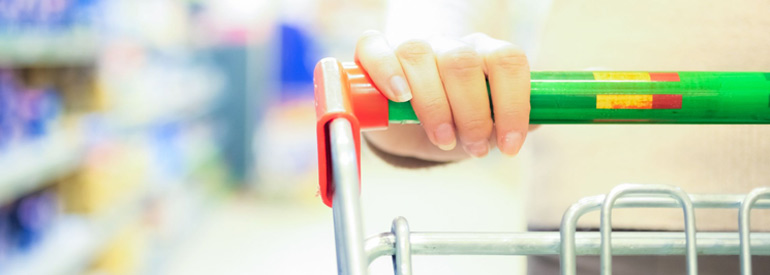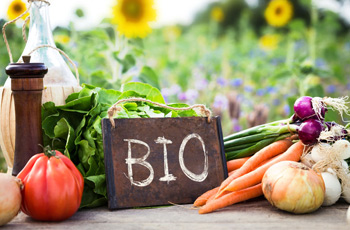
The shopping list: we choose organic, seasonal and sustainable

“Downstream” considerations…
We are part of an ecosystem … but what exactly is an ecosystem? Any vocabulary defines it as: “a set of living beings and non-living matter that interact in an environment, constituting a self-sufficient system in dynamic balance”.
This is the first reason that should lead us to approach food with a vision that goes beyond the purchase price of what we bring to the table. A greater demand leads a more rapid change organic farming should not exist as a ‘niche product’ because the whole agri-food system should be based on respect for the ecosystem.
The choice of organic and seasonal products, are not only synonymous with ‘healthy’ but also aims to support an agriculture based on the intrinsic fertility of the soil, on the use of rotational crops or poly-culture, that is different cultivations that coexist in the same land or that are alternated from one year to the next, the set-aside of the land or even the coexistence of ‘protective plants‘, often leguminous or annual herbaceous plants that increase the natural biological control capacity of parasites, also improving the microclimates of crops . Without going too long, we must also consider the reduction of emissions in the environment of climate-changing gases typical of conventional crops / farms, considered one of the main causes of climate change.
The virtuous link between organic farming and biodiversity is supported by a growing number of scientific evidences. A comparative study between organic and conventional arable crops found that in the first case there is 57% more species of spontaneous plants, with a doubling of rare species; as well as a doubling of the species of invertebrate animals (e.g. earthworms, insects) useful for crop maintenance.
…Organic for everyone…
Organic farming is synonymous with sustainable development, but above all sustainable development, since it is an agriculture that supports the maintenance of ecosystems and biodiversity. This leads to the recovery of a self-sustaining balance and, if it is sustained and respected, it will also benefit future generations. The organic supports crops and livestock that respect as much as possible the natural habitat of plants and animals, the seasonality and the use of renewable energies.
Many small realities, easily available in local markets managed by direct producers or through GAS (sustainable buying groups), are increasing the cultivation of local varieties of plants and breeding of native breeds of animals, respecting their nature. A greater number of organic farms in a given geographical area leads to an enrichment of the territory’s biodiversity and landscape. Certainly the conversion is not immediate but takes from 1 to 5 years, depending on the starting conditions (exploitation / overcropping, use of pesticides / zoopharmaceuticals, etc.).
…from the field to the table
Starting from the fact that the daily intake of food per capita, at least for the industrialized countries, is in excess and that the incorrect diet is considered a cause of chronic pathologies and deaths, we try to give us some basic rules to make a conscious shopping.
 A food produced in ‘organic regime’ provides the consumer with healthy food, free of toxic substances and richer in nutrients, both in macronutrients terms (carbohydrates, proteins and fats, including essential fatty acids, PUFA mainly of the omega 6 series), that of micronutrients (vitamins, mineral and in general bioactive substances that support metabolic processes).
A food produced in ‘organic regime’ provides the consumer with healthy food, free of toxic substances and richer in nutrients, both in macronutrients terms (carbohydrates, proteins and fats, including essential fatty acids, PUFA mainly of the omega 6 series), that of micronutrients (vitamins, mineral and in general bioactive substances that support metabolic processes).
Biodiversity also lies in starting with raw materials, such as ancient cereals, which guarantee nutritionally richer and less harmful products. It is always good to reduce the assumption of over-processed foods in favor of raw materials; better grains in grain than baked products, fresh and not frozen or packaged vegetables, fresh fruit than fruit juices, fresh fish, fished, meat from animals fed with cereals and not flours, preferably ‘closed circuit’ products from the same company .
There is also a seasonality for fish; there are species that are mainly found in autumn / winter such as turbot and mullet, others in spring / summer such as anchovies, seabream and sea bass and others all year round. It is always better to buy small-sized fish caught and not bred, respecting the fishing of small-fish.
In conclusion, the rules of conscious shopping must consider 0 kilometer rule, respect for ecosystems and seasonality. Choosing the food we consume is a great form of freedom.
The American journalist Michael Pollan in one of his books gives us a fundamental advice “… when you go shopping, take your great-grandmother with you (as the grandmother may be too young) and buy only what she recognizes as food “.
Bibliography
(1) Il manuale del Biologico; D.Caccioni, L. Colombo – Edagricole
(2) Michael Pollan ‘ In difesa del cibo’ – Adelphi
(3) https://www.slowfood.it/wp-content/uploads/2014/09/Mangiamoli_Giusti_no_abb.pdf
(4) https://www.thelancet.com/journals/lancet/article/PIIS0140-6736(19)30041-8/fulltext
Article by:
Dr.ssa Maria Elena Cafagna – Nutritionist Biologist
The dietary advice in this article is not intended to replace a personalised dietary plan and should be adapted to specific cases.
Photo: 123RF Archivio Fotografico | 17547518 ©Luca Bertolli/123rf.com | 60189836 ©pasiphae /123rf.com
- On 28 June 2019



